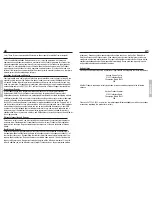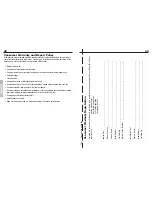
16
F G - 3 0 / F G - 3 6 E N G I N E M O U N T I N G A N D M U F F L E R A T T A C H M E N T
F G - 3 0 / F G - 3 6 T H R O T T L E L I N K A G E A N D P R O P E L L E R
17
Engine Mounting
and Muffler
Attachment Notes
Photo is of the engine
mount for the FG-36
Mount the FG-30 or FG-36 engine on aircraft-
grade plywood with more than 10mm of
thickness or to a mount of equivalent strength,
and firmly fixed, with 4 bolts. We highly
recommend the use of the Saito Motor Mount
(SAIG3095 for the FG-30 or SAIG3695 for
the FG-36) to mount this engine to a model
aircraft.
note:
Be sure to use flat washers or a metal
plate on the reverse side of the mount to
prevent the bolts from sinking into the
plywood. Before flying the airplane, be sure
to check for loose bolts.
note:
Since this engine is equipped with a
floatless carburetor with a diaphragm pump,
the direction of the cylinder and the position
of the fuel tank can be upright or inverted.
Figure 1
FG-30/FG-36 = 19mm wrench
When you attach the muffler, use a drop of oil
on the threads to ease the assembly. Screw
the exhaust manifold into the engine exhaust
port and the muffler as far as the thread will
allow (see above drawing). Notice the use of
the two wrenches used in tightening the two
nuts on the muffler/manifold connection. Use
of threadlock is recommended.
Remember to ensure cooling air passes by the
engine and muffler in a cowled environment.
iMPOrTanT:
Air is necessary to cool the
engine during operation. Make sure that
sufficient air circulation through the cowling
is provided. As a basic reference, the outlet
area should be 3 to 5 times the area of the
inlet area to provide adequate cooling.
Throttle Linkage
Carefully attach the throttle linkage to the
engine using a ball link on the carburetor
throttle arm. Make sure the linkage is free
to operate from low throttle to high throttle.
Also, confirm that the low-throttle setting on
the transmitter closes the carburetor throttle
barrel to the low-idle position. Adjust the
length of the pushrod until full throttle opens
the carburetor throttle barrel to the fully
open position, while low throttle, low trim
completely closes the throttle barrel.
Propeller
Recommended Propeller Sizes:
The recommended propeller sizes are shown
in the table below. The use of a carbon fiber
propeller is highly recommended. Remember
that the use of a large propeller will require
care in balancing it. Vibration will reduce
performance and can result in damage to the
engine and airframe.
For break-in, Saito recommends the use of
a smaller propeller for initial break-in and
approximately 20 subsequent flights.
Fg-30
Fg-36
16 x 8–10"
17 x 10–13"
17 x 6–8"
18 x 8–10"
18 x 6"
19 x 8–10"
20 x 8"
Diameter x Pitch (inches)
The FG-30 and FG-36 engines produce
maximum output when the engine is running
at about 8,300–9,000 rpm.
Propeller and Fuel
Consumption
In order to decrease fuel consumption and
prolong the life of the enginelife of the engine,
select a propeller that maximizes rpm’s when
the throttle is fully open, and an airframe that
performs flights at about 90% of the propeller
output. If the load is large, (the diameter and
pitch of the propeller is large) the air-fuel
mixture will have to be rich. If the load is
small, the rpm’s will be high, but the fuel
consumption is lowered because the
high-speed needle valve is closed or leaned
out more.








































